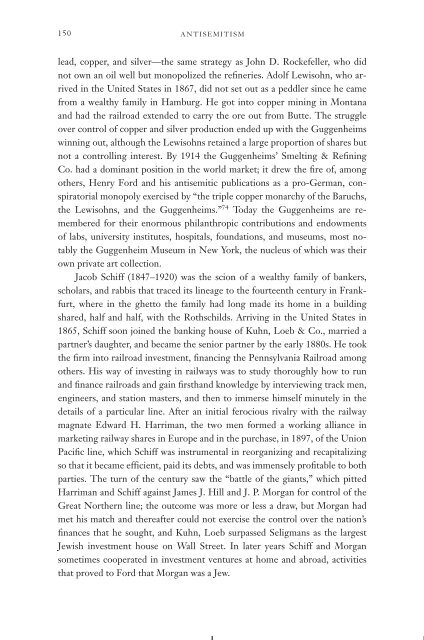41845358-Antisemitism
41845358-Antisemitism
41845358-Antisemitism
Create successful ePaper yourself
Turn your PDF publications into a flip-book with our unique Google optimized e-Paper software.
150 ANTISEMITISM<br />
lead, copper, and silver—the same strategy as John D. Rockefeller, who did<br />
not own an oil well but monopolized the refineries. Adolf Lewisohn, who arrived<br />
in the United States in 1867, did not set out as a peddler since he came<br />
from a wealthy family in Hamburg. He got into copper mining in Montana<br />
and had the railroad extended to carry the ore out from Butte. The struggle<br />
over control of copper and silver production ended up with the Guggenheims<br />
winning out, although the Lewisohns retained a large proportion of shares but<br />
not a controlling interest. By 1914 the Guggenheims’ Smelting & Refining<br />
Co. had a dominant position in the world market; it drew the fire of, among<br />
others, Henry Ford and his antisemitic publications as a pro-German, conspiratorial<br />
monopoly exercised by “the triple copper monarchy of the Baruchs,<br />
the Lewisohns, and the Guggenheims.” 74 Today the Guggenheims are remembered<br />
for their enormous philanthropic contributions and endowments<br />
of labs, university institutes, hospitals, foundations, and museums, most notably<br />
the Guggenheim Museum in New York, the nucleus of which was their<br />
own private art collection.<br />
Jacob Schiff (1847–1920) was the scion of a wealthy family of bankers,<br />
scholars, and rabbis that traced its lineage to the fourteenth century in Frankfurt,<br />
where in the ghetto the family had long made its home in a building<br />
shared, half and half, with the Rothschilds. Arriving in the United States in<br />
1865, Schiff soon joined the banking house of Kuhn, Loeb & Co., married a<br />
partner’s daughter, and became the senior partner by the early 1880s. He took<br />
the firm into railroad investment, financing the Pennsylvania Railroad among<br />
others. His way of investing in railways was to study thoroughly how to run<br />
and finance railroads and gain firsthand knowledge by interviewing track men,<br />
engineers, and station masters, and then to immerse himself minutely in the<br />
details of a particular line. After an initial ferocious rivalry with the railway<br />
magnate Edward H. Harriman, the two men formed a working alliance in<br />
marketing railway shares in Europe and in the purchase, in 1897, of the Union<br />
Pacific line, which Schiff was instrumental in reorganizing and recapitalizing<br />
so that it became efficient, paid its debts, and was immensely profitable to both<br />
parties. The turn of the century saw the “battle of the giants,” which pitted<br />
Harriman and Schiff against James J. Hill and J. P. Morgan for control of the<br />
Great Northern line; the outcome was more or less a draw, but Morgan had<br />
met his match and thereafter could not exercise the control over the nation’s<br />
finances that he sought, and Kuhn, Loeb surpassed Seligmans as the largest<br />
Jewish investment house on Wall Street. In later years Schiff and Morgan<br />
sometimes cooperated in investment ventures at home and abroad, activities<br />
that proved to Ford that Morgan was a Jew.


